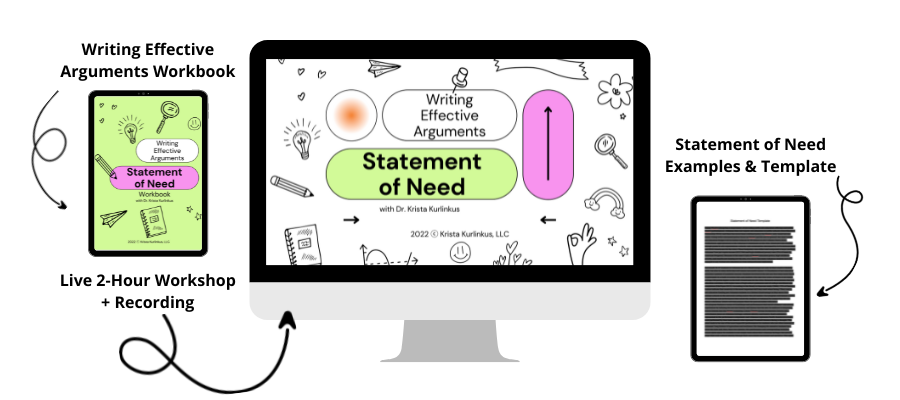The statement of need . . . of all the sections of the grant, this is the most complex because it involves the most research and argumentation.
Today I’m going to share some strategies for laying the foundation for a well-argued statement of need.
Before we go any further, let’s review what a statement of need is and what it is not.
This section of a grant is where you seek to convince the grantmaker of the need for your work. While it seems obvious to you that the cause you’re addressing is important, it’s important to step back and consider how to convince the grantmaker that your work, of all the work being done by nonprofits, is what they should fund right now.
The statement of need is not a section to describe why you need funding or what you’ll do with the funding; it’s all about the need for your organization and/or your program.
Read on to learn:
- The questions you should ask first
- The role of research in your statement of need
- Your next steps
The question you should ask first
When I teach the statement of need in Grant Writing Made Easy, I encourage people to start by writing about why they first started doing the work they’re seeking funding for. So for example, if you run an after school program, why did you start it? Get specific about the very moment you saw the need for your work.
Did you talk to a teacher about the need for after school tutoring? Did you hear from a parent you know that they needed a safe place for their child to spend the after school hours? Maybe you’re a parent, and you saw the need in your own child’s school.
And what did you first hope to accomplish with the program? In this example, maybe it’s better reading test scores. Maybe it’s better social and emotional skills. Maybe it’s a sense of community in a school that had a problem with bullying.
Once you write down your personal story for doing the work, begin looking for the assumptions within it.
Let’s say you started the after school program for students at a local high school to help them with their post-secondary planning. Two of the assumptions underlying this program are that post-secondary planning leads to better outcomes for students when they leave high school and that meeting with a trusted adult will help students with their post-secondary planning. There are also local factors that you need to consider – what are post-secondary attainment rates in the school you’re working in (i.e. how many students attend college, trade school, or enter the workforce after graduation) and does the high school have a guidance counseling staff that meets the needs of the students.
Once you have your origin story down, list the assumptions and then ask questions to guide your research. Again, while it may be obvious to you that the particular community you’re working in needs an after school program, it won’t be obvious to the grantmaker.
So in this example, you could list the following questions (and more, but these are a good starting point):
- What research supports the claim that post-secondary planning leads to better outcomes for high school graduates?
- What does the research say about the role of a trusted adult in a student’s post-secondary planning?
- What were the post-secondary attainment rates in your school before you started your program? (And has there been a change?)
- How does the ratio of guidance counseling staff to students affect post-secondary attainment rates?
Again, this list of questions could go on and on, but these are a good starting point. Start with a few questions, and then use those to guide your research. (Read on for more about the role of research in a statement of need.)
The role of research in a statement of need
Once you have your list of questions, you’ll need answers! That is where research comes in.
Grantmakers want to hear not only what you have to say about the need, but also what the research says about the need.
Incorporating research is one of the best ways to boost your ethos (or credibility) to a grantmaker.
With that in mind, I have a few best practices for using research. First of all, make sure the research you include is credible. It’s not enough to do a quick Google search and pull the first statistic you find, if it’s coming from a source that can’t be trusted. A good rule of thumb is to go to government and academic sources first, and then go on a case-by-case basis with other sources.
Secondly, you need to make sure the research is relevant and timely. If you’re based in Detroit and writing a statement of need for the post-secondary planning after school program, it’s best to include statistics that are as local as you can get them and within the past few years.
Third, don’t stop at demographic data or statistics. You can also use research to support your program strategies. You’ll do more of this in the program design section, but you can include some of it in the statement of need. For example, what does the academic literature say about the importance of high school students having a trusted adult involved in their post-secondary planning.
You can draw a throughline from the ratio of guidance counselors to students to the need for your program, if the research says that it’s important for students to spend time developing trust with the adult helping them plan for what’s next after high school.
How to conduct research and integrate it into your writing is a whole other discussion, and I don’t want to overwhelm you right now. Read on for your next steps.
Your next steps
Once you’ve written the story of how you became aware of the need for your work and brainstormed a list of questions you need to answer with research, you’ve laid the groundwork for a compelling and well-argued statement of need.
The work does not end there, though.
Like I said, there are strategies you can use to find the right information (credible, relevant, and timely) and particular techniques that you can use to integrate that information into your own writing.
I am covering all this and more in the first-ever Statement of Need Workshop.
I’ve done workshops like this before, but this is the first one I’m doing on the statement of need.
Here is what’s included when you sign up:
→ 2-hour live training on September 29 at 11 am CT/12 pm ET
→ Fillable workbook
→ Slides and recording of the training
→Templates and example statements of need
Registration is open right now. We’re capping this event at 150 people, so make sure you save your spot ASAP!







